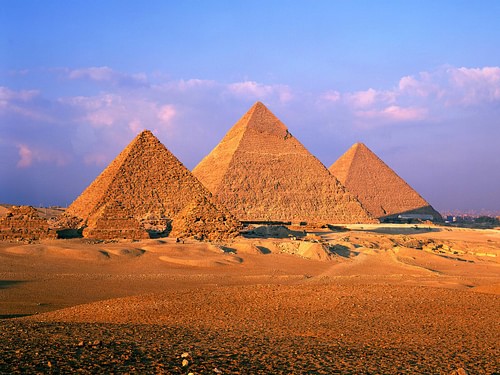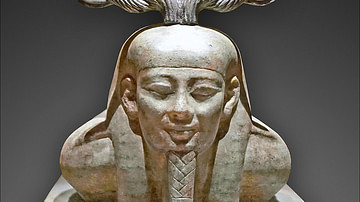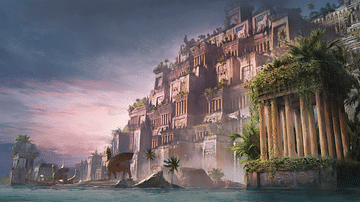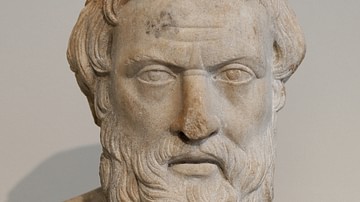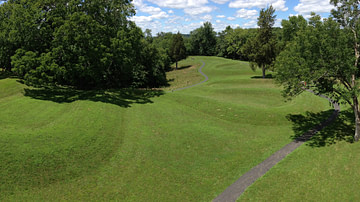
The Great Pyramid of Giza is a defining symbol of Egypt and the last of the ancient Seven Wonders of the World. It is located on the Giza plateau near the modern city of Cairo and was built over a twenty-year period during the reign of the king Khufu (2589-2566 BCE, also known as Cheops) of the 4th Dynasty.
Until the Eiffel Tower was completed in Paris, France in 1889, the Great Pyramid was the tallest structure made by human hands in the world; a record it held for over 3,000 years and one unlikely to be broken. Other scholars have pointed to the Lincoln Cathedral spire in England, built in 1300, as the structure which finally surpassed the Great Pyramid in height but, still, the Egyptian monument held the title for an impressive span of time.
The pyramid rises to a height of 479 feet (146 metres) with a base of 754 feet (230 metres) and is comprised of over two million blocks of stone. Some of these stones are of such immense size and weight (such as the granite slabs in the King's Chamber) that the logistics of raising and positioning them so precisely seems an impossibility by modern standards.
The pyramid was first excavated using modern techniques and scientific analysis in 1880 by Sir William Matthew Flinders Petrie (l.1853-1942), the British archaeologist who set the standard for archaeological operations in Egypt generally and at Giza specifically. Writing on the pyramid in 1883, Flinders Petrie noted:
The Great Pyramid has lent its name as a sort of by-word for paradoxes; and, as moths to a candle, so are theorisers attracted to it. (1)
Although many theories persist as to the purpose of the pyramid, the most widely accepted understanding is that it was constructed as a tomb for the king. Exactly how it was built, however, still puzzles people in the modern day. The theory of ramps running around the outside of the structure to move the blocks into place is still debated by historians. So-called "fringe" or "New Age" theories abound, in an effort to explain the advanced technology required for the structure, citing extra-terrestrials and their imagined frequent visits to Egypt in antiquity.
These theories continue to be advanced in spite of the increasing body of evidence substantiating that the pyramid was built by the ancient Egyptians using technological means which, most likely, were so common to them that they felt no need to record them. Still, the intricacy of the interior passages, shafts, and chambers (The King's Chamber, Queen's Chamber, and Grand Gallery) as well as the nearby Osiris Shaft, coupled with the mystery of how the pyramid was built at all and its orientation to cardinal points, encourages the persistence of these fringe theories.
Another enduring theory regarding the monument's construction is that it was built on the backs of slaves. Contrary to the popular opinion that Egyptian monuments in general, and the Great Pyramid in particular, were built using Hebrew slave labor, the pyramids of Giza and all other temples and monuments in the country were constructed by Egyptians who were hired for their skills and compensated for their efforts. No evidence of any kind whatsoever - from any era of Egypt's history - supports the narrative events described in the biblical Book of Exodus.
Worker's housing at Giza was discovered and fully documented in 1979 by Egyptologists Lehner and Hawass but, even before this evidence came to light, ancient Egyptian documentation substantiated payment to Egyptian workers for state-sponsored monuments while offering no evidence of forced labor by a slave population of any particular ethnic group. Egyptians from all over the country worked on the monument, for a variety of reasons, to build an eternal home for their king which would last through eternity.
Pyramids & the Giza Plateau
Toward the end of the Early Dynastic Period (c. 3150-c.2613 BCE) the vizier Imhotep ((c. 2667-2600 BCE) devised a means of creating an elaborate tomb, unlike any other, for his king Djoser. Prior to Djoser's reign (c. 2670 BCE) tombs were constructed of mud fashioned into modest mounds known as mastabas. Imhotep conceived of a then-radical plan of not only building a mastaba out of stone but of stacking these structures on top of one another in steps to create an enormous, lasting, monument. His vision led to the creation of Djoser's Step Pyramid at Saqqara, still standing in the present day, the oldest pyramid in the world.
Still, the Step Pyramid was not a "true pyramid" and, in the period of the Old Kingdom (c. 2613-2181 BCE) the king Sneferu (r.c. 2613-2589 BCE) sought to improve on Imhotep's plans and create an even more impressive monument. His first attempt, the Collapsed Pyramid at Meidum, failed because he departed too widely from Imhotep's design. Sneferu learned from his mistake, however, and went to work on another - the Bent Pyramid - which also failed because of miscalculations in the angle from base to summit. Undeterred, Sneferu took what he learned from that experience and built the Red Pyramid, the first true pyramid constructed in Egypt.
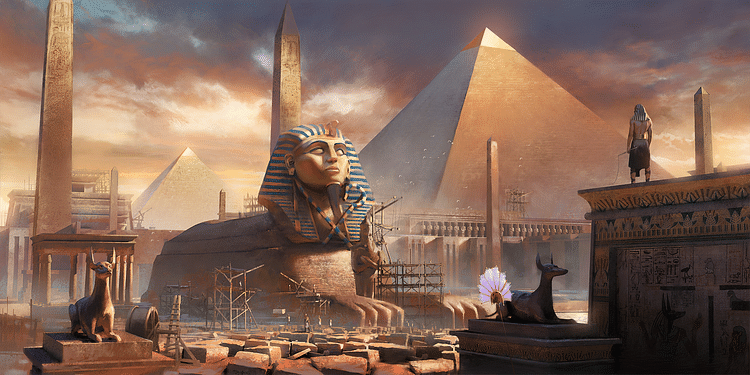
Building a pyramid required enormous resources and the maintenance of a wide array of all kinds of skilled and unskilled workers. The kings of the 4th Dynasty - often referred to as "the pyramid builders" - were able to command these resources because of the stability of the government and the wealth they were able to acquire through trade. A strong central government, and a surplus of wealth, were both vital to any efforts at pyramid building and these resources were passed from Sneferu, upon his death, to his son Khufu.
Khufu seems to have set to work on building his grand tomb shortly after coming to power. The rulers of the Old Kingdom governed from the city of Memphis and the nearby necropolis of Saqqara was already dominated by Djoser's pyramid complex while other sites such as Dashur had been used by Sneferu. An older necropolis, however, was also close by and this was Giza. Khufu's mother, Hetepheres I (l.c. 2566 BCE), was buried there and there were no other great monuments to compete for attention close by; so Khufu chose Giza as the site for his pyramid.
Construction of the Pyramid
The first step in constructing a pyramid, after deciding upon the best location, was organizing the crews and allocating resources and this was the job of the second-most powerful man in Egypt, the vizier. Khufu's vizier was Hemiunu, his nephew, credited with the design and building of the Great Pyramid. Hemiunu's father, Nefermaat (Khufu's brother) had been Sneferu's vizier in his pyramid-building projects and it is probable he learned a great deal about construction from these experiences.

Because of their immense size, building pyramids posed special problems of both organization and engineering. Constructing the Great Pyramid of the pharaoh Khufu, for example, required that more than two million blocks weighing from two to more than sixty tons be formed into a structure covering two football fields and rising in a perfect pyramidal shape 480 feet into the sky. Its construction involved vast numbers of workers which, in turn, presented complex logistical problems concerning food, shelter, and organization. Millions of heavy stone blocks needed not only to be quarried and raised to great heights but also set together with precision in order to create the desired shape. (217)
It is precisely the skill and technology required to "create the desired shape" which presents the problem to anyone trying to understand how the Great Pyramid was built. Modern-day theories continue to fall back on the concept of ramps which were raised around the foundation of the pyramid and grew higher as the structure grew taller. The ramp theory, still debated, maintains that, once the foundation was firm, these ramps could have easily been raised around the structure as it was built and provided the means for hauling and positioning tons of stones in precise order.
Aside from the problems of a lack of wood in Egypt to make an abundance of such ramps, the angles workers would have had to move the stones up, and the impossibility of moving heavy stone bricks and granite slabs into position without a crane (which the Egyptians did not have), the most serious problem comes down to the total impracticability of the ramp theory. Brier and Hobbs explain:
The problem is one of physics. The steeper the angle of an incline, the more effort necessary to move an object up that incline. So, in order for a relatively small number of men, say ten or so, to drag a two-ton load up a ramp, its angle could not be more than about eight percent. Geometry tells us that to reach a height of 480 feet, an inclined plane rising at eight percent would have to start almost one mile from its finish. It has been calculated that building a mile-long ramp that rose as high as the Great Pyramid would require as much material as that needed for the pyramid itself - workers would have had to build the equivilent of two pyramids in the twenty-year time frame. (221)
A variation on the ramp theory was proposed by the French architect Jean-Pierre Houdin who claims ramps were used inside of the pyramid. Houdin believes that ramps may have been used externally in the initial stages of construction but, as the pyramid grew taller, work was done internally. The quarried stones were brought in through the entrance and moved up the ramps to their position. This, Houdin claims, would account for the shafts one finds inside the pyramid. This theory, however, does not account for the weight of the stones or the number of workers on the ramp required to move them up an angle inside the pyramid and into position.
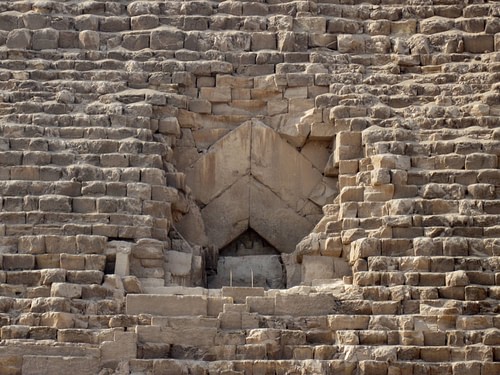
The ramp theory in either of these forms fails to explain how the pyramid was built while a much more satisfactory possibility rests right below the monument: the high water table of the Giza plateau. Engineer Robert Carson, in his work The Great Pyramid: The Inside Story, suggests that the pyramid was built using water power. Carson also suggests the use of ramps but in a much more cogent fashion: the interior ramps were supplemented by hydraulic power from below and hoists from above.
Although the Egyptians had no knowledge of a crane as one would understand that mechanism in the present day, they did have the shaduf, a long pole with a bucket and rope at one end and counter-weight at the other, typically used for drawing water from a well. Hydraulic power from below, coupled with hoists from above could have moved the stones throughout the interior of the pyramid and this would also account for the shafts and spaces one finds in the monument which other theories have failed to fully account for.
It is abundantly clear that the water table at Giza is still quite high in the present day and was higher in the past. Egyptologist Zahi Hawass, writing on his excavation of the Osiris Shaft near the Great Pyramid in 1999, notes how "the excavation proved to be very challenging mainly due to the dangerous nature of the work caused by the high water table" (381). In the same article, Hawass notes how, in 1945, guides at Giza were regularly swimming in the waters of this underground shaft and that "the rising water table in the shaft prevented scholars from studying it further" (379).
Further, earlier attempts to excavate the Osiris Shaft - by Selim Hassan in the 1930's - and observations (though no excavation) of the shaft by Abdel Moneim Abu Bakr in the 1940's - also make note of this same high water table. Geological surveys have determined that the Giza plateau and surrounding region was much more fertile in the time of the Old Kingdom than it is today and that the water table would have been higher.
Considering this, Carson's theory of water power used in building the pyramid makes the most sense. Carson claims the monument "could only be constructed by means of hydraulic power; that a hydraulic transportation system was set up inside the Great Pyramid" (5). Harnessing the power of the high water table, the ancient builders could have constructed the pyramid much more reasonably than by some form of exterior ramping system.
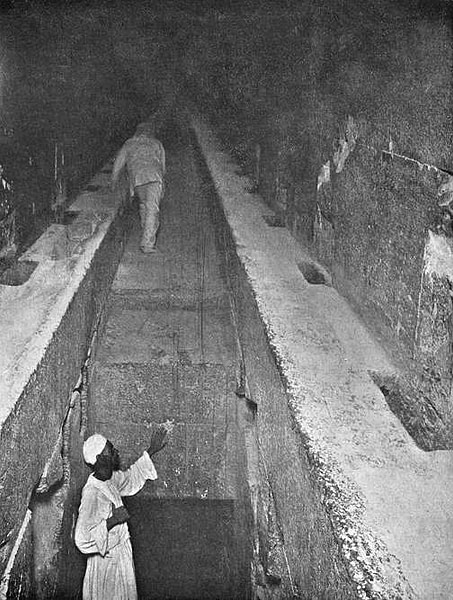
Once the interior was completed, the whole of the pyramid was covered in white limestone which would have shone brilliantly and been visible from every direction for miles around the site. As impressive as the Great Pyramid is today, one must recognize that it is a monument in ruin as the limestone long ago fell away and was utilized as building material for the city of Cairo (just as the nearby city of ancient Memphis was).
When it was completed, the Great Pyramid must have appeared as the most striking creation the Egyptians had ever seen. Even today, in its greatly weathered state, the Great Pyramid inspires awe. The sheer size and scope of the project is literally amazing. Historian Marc van de Mieroop writes:
The size boggles the mind: it was 146 meters high (479 feet) by 230 meters at the base (754 feet). We estimate that it contained 2,300,000 blocks of stone with an average weight of 2 and 3/4 tons some weighing up to 16 tons. Khufu ruled 23 years according to the Turin Royal Canon, which would mean that throughout his reign annually 100,000 blocks - daily about 285 blocks or one every two minutes of daylight - had to be quarried, transported, dressed, and put in place...The construction was almost faultless in design. The sides were oriented exactly toward the cardinal points and were at precise 90-degree angles. (58)
The workers who accomplished this were skilled and unskilled laborers hired by the state for the project. These workers either volunteered their efforts to pay off a debt, for community service, or were compensated for their time. Although slavery was an institution practiced in ancient Egypt, no slaves, Hebrew or otherwise, were used in creating the monument. Brier and Hobbs explain the logistics of the operation:
Were it not for the two months every year when the Nile's water covered Egypt's farmland, idling virtually the entire workforce, none of this construction would have been possible. During such times, a pharaoh offered food for work and the promise of a favored treatment in the afterworld where he would rule just as he did in this world. For two months annually, workmen gathered by the tens of thousands from all over the country to transport the blocks a permanent crew had quarried during the rest of the year. Overseers organized the men into teams to transport the stones on sleds, devices better suited than wheeled vehicles to moving weighty objects over shifting sand. A causeway, lubricated by water, smoothed the uphill pull. No mortar was used to hold the blocks in place, only a fit so exact that these towering structures have survived for 4,000 years. (17-18)
The yearly inundation of the Nile River was essential for the livelihood of the Egyptians in that it deposited rich soil from the riverbed all across the farmlands of the shore; it also, however, made farming those lands an impossibility during the time of the flood. During these periods, the government provided work for the farmers through labor on their great monuments. These were the people who did the actual, physical, work in moving the stones, raising the obelisks, building the temples, creating the pyramids which continue to fascinate and inspire people in the present day.
It is a disservice to their efforts and their memory, not to mention the grand culture of the Egyptians, to continue to insist that these structures were created by poorly treated slaves who were forced into their condition because of ethnicity. The biblical Book of Exodus is a cultural myth purposefully created to distinguish one group of people living in the land of Canaan from others and should not be regarded as history.
The Great Pyramid as Tomb
All of this effort went to creating a grand tomb for the king who, as mediator between the gods and the people, was thought to be deserving of the finest of tombs. Theories regarding the original purpose of the Great Pyramid range from the fanciful to the absurd, and may be investigated elsewhere, but the culture which produced the monument would have regarded it as a tomb, an eternal home for the king.
Tombs which have been excavated throughout Egypt, from the most modest to the rich example of Tutankhamun's - along with other physical evidence - make clear the ancient Egyptian belief in a life after death and the concern for the soul's welfare in this new world. Grave goods were always placed in the tomb of the deceased as well as, in wealthier tombs, inscriptions and paintings on the walls (known as the Pyramid Texts, in some cases). The Great Pyramid is simply the grandest form of one of these tombs.
Arguments against the Great Pyramid as a tomb cite the fact that no mummies or grave goods have ever been found inside. This argument willfully ignores the plentiful evidence of grave robbing from ancient times to the present. Egyptologists from the 19th century onwards have recognized that the Great Pyramid was looted in antiquity and, most likely, during the time of the New Kingdom (c. 1570-1069 BCE) when the Giza necropolis was replaced by the area now known as The Valley of the Kings near Thebes.
This is not to suggest that Giza was forgotten, there is ample evidence of New Kingdom pharaohs such as Ramesses the Great (r. 1279-1213 BCE) taking great interest in the site. Rameses II had a small temple built at Giza in front of the Sphinx as a token of honor and it was Rameses II's fourth son, Khaemweset, who devoted himself to preserving the site. Khaemweset never ruled Egypt but was a crown prince whose efforts to restore the monuments of the past are well documented. He is, in fact, considered the world's "first Egyptologist" for his work in restoration, preservation, and recording of ancient monuments and especially for his work at Giza.
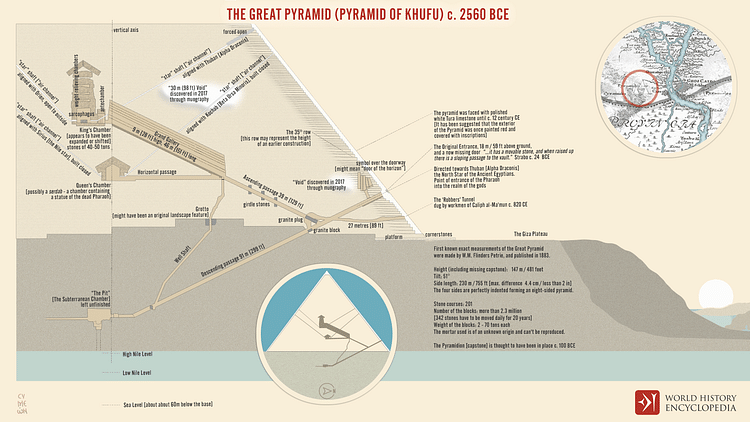
Further, work conducted on the Osiris Shaft - and other areas around the site - have shown activity during the 26th Dynasty of the Third Intermediate Period (c. 1069-525 BCE) and into the Late Period (c. 525-332 BCE). Giza was, therefore, an active site throughout Egypt's history but was not always given the kind of attention it received during the Old Kingdom.
Herodotus, writing in the 5th century BCE, reported that the Great Pyramid had been looted and visitor's to the site in the modern day enter through the so-called Robbers Tunnel created c. 820 by Caliph al-Ma'mun seeking to recover whatever treasures the pyramid held inside. Tomb robbers before and after the caliph had also visited the pyramid prior to the excavations of the 19th century. Whatever treasures the pyramid may have held in the time of Khufu could have been removed at any time from the Old Kingdom onward.
The Giza Plateau
Following Khufu's death, his son Khafre (r. 2558-2532 BCE) took the throne and began building his own pyramid next to his father's. The king Menkaure (r. 2532-2503 BCE) came after Khafre and followed the same paradigm of building his eternal home at Giza. Khafre and Menkaure added their own temple complexes and monuments, such as the Great Sphinx of Giza under Khafre's reign, but these were on a smaller scale than that of Khufu's work.
It is no accident or mystery as to why the Great Pyramid is the largest and the other two are progressively smaller: as the period of the Old Kingdom continued, with the government's emphasis on grand building projects, resources became more and more scarce. Menkaure's successor, Shepseskaf (r. 2503-2498 BCE) had the resources to complete Menkaure's pyramid complex but could afford no such luxury for himself; he was buried in a modest mastaba tomb at Saqqara.
Still, Giza continued be regarded as an important site and funds were allocated as long as they were available for its upkeep. Giza was a thriving community for centuries with temples, shops, a market place, housing, and a sturdy economy. Individuals in the present day speculating on the lonely, deserted, mystical outpost of Giza ignore the evidence of what the complex would have been like for most of Egypt's long history.
The present day understanding of the plateau as some isolated outpost of monuments encourages theories which do not align with how Giza actually was when those monuments were constructed. Theories suggesting mysterious tunnels beneath the plateau have been debunked - yet still persist - including speculations concerning the Osiris Shaft.
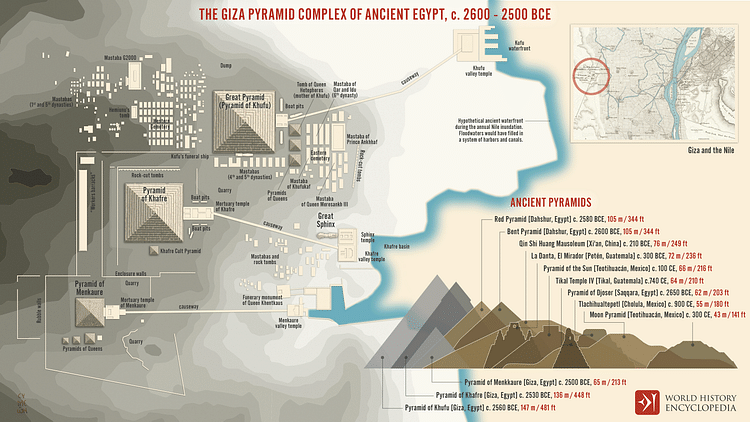
This complex of underground chambers was most likely dug, as Hawass contends, in honor of the god Osiris and may or may not have been where the king Khufu was originally laid to rest. Herodotus mentions the Osiris Shaft (though not by that name, which was only given to it recently by Hawass) in writing of Khufu's burial chamber which was said to be surrounded by water.
Excavations of the shaft and the chambers have recovered artifacts dating from the Old Kingdom through the Third Intermediate Period but no tunnels branching out beneath the plateau. Osiris, as lord of the dead, would certainly have been honored at Giza and underground chambers recognizing him as ruler in the afterlife were not uncommon throughout Egypt's history.
Although the Great Pyramid of Giza, and the other smaller pyramids, temples, monuments, and tombs there, continued to be respected throughout Egypt's history, the site fell into decline after the Roman occupation and then annexation of the country in 30 BCE. The Romans concentrated their energies on the city of Alexandria and the abundant crops the country offered, making Egypt into Rome's "bread basket", as the phrase goes.
The site was more or less neglected until Napoleon's Egyptian Campaign of 1798-1801 during which he brought along his team of scholars and scientists to document ancient Egyptian culture and monuments. Napoleon's work in Egypt attracted others to the country who then inspired still others to visit, make their own observations, and conduct their own excavations.
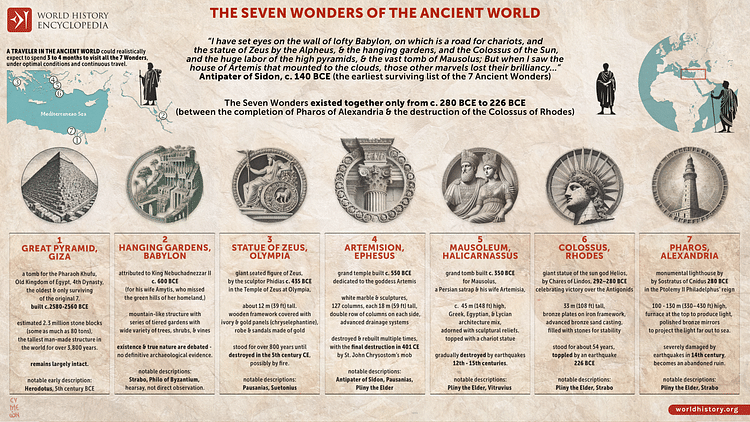
Throughout the 19th century, ancient Egypt became increasingly the object of interest for people around the world. Professional and amateur archaeologists descended upon the country seeking to exploit or explore the ancient culture for their own ends or in the interests of science and knowledge. The Great Pyramid was first fully excavated professionally by the British archaeologist Sir William Matthew Flinders Petrie whose work on the monument lay the foundation for any others who followed up to the present day.
Flinders Petrie was obviously interested in exploring every nuance of the Great Pyramid but not at the expense of the monument itself. His excavations were performed with great care in an effort to preserve the historical authenticity of the work he was examining. Although this may seem a common sense approach in the modern day, many European explorers before Flinders Petrie, archaeologists professional and amateur, brushed aside any concerns of preservation in pursuing their goal of unearthing ancient treasure troves and bringing antiquities back to their patrons. Flinders Petrie established the protocol regarding ancient monuments in Egypt which is still adhered to in the present day. His vision inspired those who came after him and it is largely due to his efforts that people today can still admire and appreciate the monument known as the Great Pyramid of Giza.
